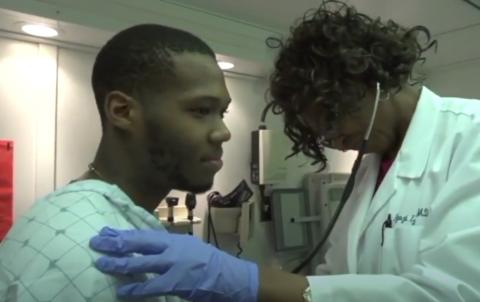Getting ‘HANDLS’ On It
Study Aims to Tackle Health Disparities Gap

It started with a hypothesis: There are biological components underlying the persistent health disparities in U.S. cities. To uncover the interconnected factors causing these disproportionate rates of disease and disability, NIH senior investigator Dr. Michele K. Evans and her team took to the streets of Baltimore, where they launched a long-term observational study in 2004—Healthy Aging in Neighborhoods of Diversity across the Life Span (HANDLS).
Even before coming to NIH, Evans saw firsthand how racial inequality and socioeconomic status can impair health outcomes. She learned this while treating patients in a public housing development and a storefront in the New York boroughs of Brooklyn and the Bronx. Evans, an internist and oncologist, currently serves as deputy scientific director and training director of NIA’s intramural research program. She discussed findings from HANDLS at a recent virtual Clinical Center Grand Rounds.
“We set out to try to understand the interaction of race and socioeconomic status on health disparities,” she said. “Are they independent actors or do they act within a context of environmental, biological and psychosocial factors? And, how do they influence the incidence and severity of age-associated disease, rates of aging and functional decline?”
This year, one of the troubling health trends is the higher rate of Covid-19 among African Americans, a burden heavily felt across Baltimore, the nation’s 30th largest city, where 63 percent of its 620,000 residents are African American. The HANDLS study is incorporating covid data on prevalence, inflammatory biomarkers and psychosocial effects of the pandemic into its ongoing epidemiologic study, said Evans, “because we feel that they’re ultimately going to influence not only survival from the disease, but also perhaps survival overall, negatively impacting mortality rates overall in the [HANDLS] cohort.”

Photo: HANDLS
HANDLS is an NIA 20-year longitudinal study that follows 3,700 Baltimore residents—African Americans and white adults, ages 30-64—living above and below the poverty line in 13 neighborhoods across the city. Investigators have retained their fixed cohort of participants by traveling to their neighborhoods in mobile medical research vehicles (MRV) every 3-4 years to conduct follow-up medical and psychological evaluations.
Now in wave 5, HANDLS continues to shed light on the unequal health burdens along racial, ethnic, gender and class lines, research that Evans hopes will lead to new diagnostics and therapeutics to help narrow the disparities gap.
One major variable of the study is the health impact of perceived discrimination, a psychological stressor commonly associated with a range of chronic diseases. Using carefully crafted surveys and medical testing, HANDLS found perceived discrimination to be a major risk factor for cardiovascular and kidney disease and cognitive decline.

Photo: HANDLS
Regardless of income, African Americans are four times more likely than whites to develop renal disease. HANDLS observed that perceived racial and gender discrimination was associated with a decline in renal function, particularly among black and white women.
“In this small section of our cohort,” said Evans, “we found that perceived discrimination at least deserves further investigation as a psychosocial risk factor for kidney disease.”
African Americans also are 40 percent more likely to have hypertension and 20 percent more likely to die from heart disease than whites. This disparity was reflected in the study; black participants often had abnormal EKG readings during routine checkups.
“In our everyday reality on the streets of Baltimore,” said Evans,” we find that our HANDLS participants frequently present with the most acute manifestation of cardiovascular disease, the MI [myocardial infarction].”
Across the country, African Americans have a persistently lower life expectancy compared with other racial and ethnic groups. As they age, African Americans—particularly those who have endured a lifetime of discrimination—also have disproportionately poor brain health.

In a sub-cohort, MRIs showed that African Americans had a greater risk of developing poor brain health and cognitive decline. Interestingly, in African Americans with higher reported discrimination, older people had increased white-matter lesion volume, a predictor of poor cognitive function and dementia risk, whereas younger people had a lower volume. This result leads Evans to speculate that, among other causes, people of different ages might have different coping mechanisms in the face of discrimination.
Why do some people remain healthier as they grow older? HANDLS has deployed several biomarker studies to examine this phenomenon.
One such biomarker is telomere length. Longer telomeres—little structures on the tips of chromosomes—are associated with good health and longevity. Shortening occurs naturally with age but can be spurred on by mental stress and other environmental factors. HANDLS data revealed that women with greater lifetime burden of racial or gender discrimination, those with higher socioeconomic status reporting greater lifetime burden of racial discrimination and younger adults reporting greater exposure to multiple sources of discrimination had shorter telomere length.

Photo: HANDLS
“Our findings are concordant with what some other laboratories have shown,” said Evans, “that perhaps interpersonal discrimination and environmental factors related to stress are related to cellular aging and may contribute to…the accelerated aging phenotype we see associated with health disparities.”
Evans and colleagues continue to analyze new study data with the hope of ultimately improving the health and longevity of the populations they serve. Watching the current covid crisis unfold has made Evans even more vigilant in her quest for justice. As HANDLS goes into its next wave, she aims to continue moving forward inclusively, fairly distributing NIH research resources and making sure populations in need reap the benefits of study results.
“The bioethical principle of justice must guide us all,” she concluded, “as we strive for health equity.”
